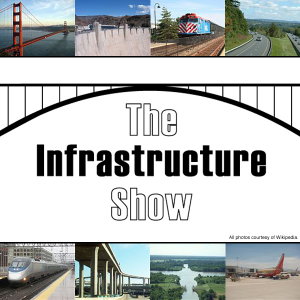
The Infrastructure Show - Podcasts
US News
The Infrastructure Show consists of monthly podcasts in which some of the nation’s top infrastructure experts discuss with host Professor Joseph Schofer of Northwestern University the condition of our infrastructure today, and what can be done about it. While many subjects are addressed, including repairs, upgrades and new construction, there is an emphasis on the topics of preventive and predictive maintenance, as well as “structural health monitoring” – a special focus of the Northwestern Infrastructure Technology Institute, of which Dr. Schofer is Director.
Location:
United States
Description:
The Infrastructure Show consists of monthly podcasts in which some of the nation’s top infrastructure experts discuss with host Professor Joseph Schofer of Northwestern University the condition of our infrastructure today, and what can be done about it. While many subjects are addressed, including repairs, upgrades and new construction, there is an emphasis on the topics of preventive and predictive maintenance, as well as “structural health monitoring” – a special focus of the Northwestern Infrastructure Technology Institute, of which Dr. Schofer is Director.
Language:
English
Fast-Growing Cities Need Rapid Water System Upgrades – How Irving, Texas, Does It
Duration:00:33:19
Removing Dams on the Klamath River – Why and How
Duration:00:24:22
Rebooting Three Mile Island
Rebooting Three Mile Island
Duration:00:22:20
Financing Transportation Through Public-Private Partnerships
Duration:00:34:19
The TVA After Nine Decades
Ship Collisions with Bridges – the Risks and Protection Options
Duration:00:32:24
Transformers – Their Vital Role in Ensuring Electric Grid Reliability
Duration:00:20:01
Rebuilding Chicago Transit Authority’s Red and Purple Rail Lines
Duration:00:21:33
Tsunami Evacuation Towers – Reaching for the Sky to Save Lives
Duration:00:28:23
Digital Twins – Modeling Infrastructure Systems for Design, Operations, and Management
Duration:00:26:18
Dam Failures in the U.S. – the Risks and Risk Management
Duration:00:26:32
The Eads Bridge at 150: A Story of Innovation in Design, Materials, and International Finance
Duration:00:30:08
Saving Intercity Bus Terminals
Duration:00:19:20
Big Infrastructure for Big Science - The Deep Underground Neutrino Experiment
Duration:00:26:59
Let Drones Do It – Taking on Bridge Inspection
Duration:00:18:53
The Global Positioning Satellite System – Fifty Years of Success
Duration:00:23:30
Locking the Door on Cyberattacks
Duration:00:24:35
Delivering Energy on Demand: Grid-Scale Storage
Duration:00:20:56
When Permafrost isn’t Permanent – Building Infrastructure in Cold Regions
Duration:00:17:42